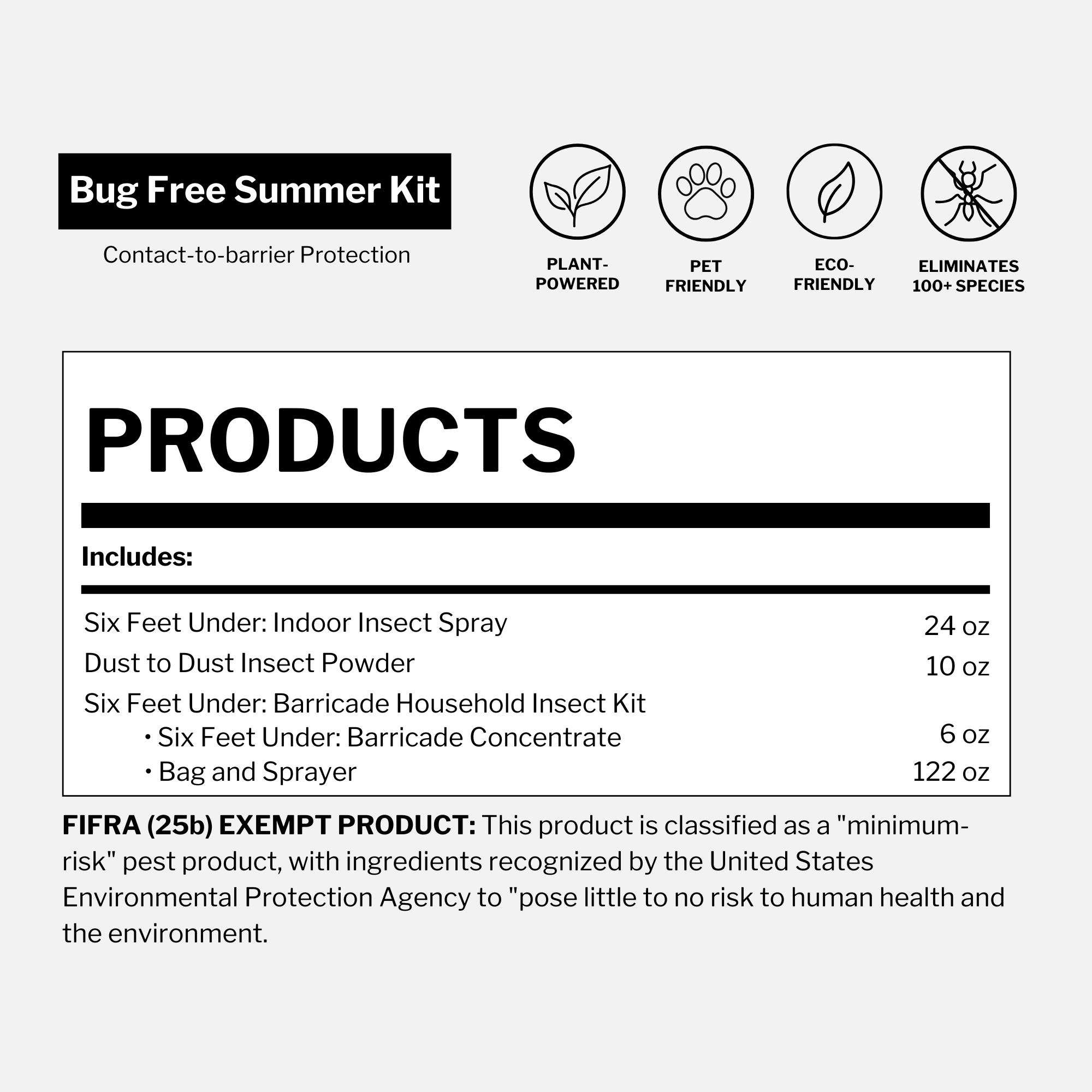Published July 18, 2023 • Updated November 7, 2025
Reviewed by Julie Miller, BA in Language Arts, Editorial Lead, Dr. Killigan’s
TL;DR: Insects keep nature running: they pollinate plants, recycle waste into healthy soil and control pests so gardens and ecosystems thrive. Most belong outside, not in your home. Dr. Killigan’s offers plant-powered, eco-friendly pest control that keeps invaders out without synthetic pesticides and is safe when used as directed around pets and family.
Insects aren’t just buzzing nuisances at picnics or uninvited guests in our homes. They are the tiny engineers that keep the natural world running. Every flower that blooms, every forest that thrives and even the soil beneath our feet depend on their quiet work.
So, why do bugs exist? Here’s what they actually do for our planet—and why they still don’t belong inside your home.
Insects kickstart growth: Nature’s pollinators
Roughly 75% of the world’s flowering plants rely on insects for pollination, including many of the foods we eat.
As bees, butterflies and beetles move from bloom to bloom collecting nectar, they transfer pollen—helping plants reproduce and ensuring crops flourish. Think of them as nature’s tiny messengers, keeping gardens blooming and food growing.
Top pollinators:
- Honeybees & bumble bees—champions of fruit and vegetable pollination.
- Butterflies—essential for wildflowers and gardens.
- Hoverflies & beetles—often overlooked, yet powerful pollen carriers with ancient lineages dating back millions of years.
Without them, our plates would be emptier and our landscapes far less colorful.

How honey bees keep ecosystems alive
When a honey bee lands on a flower, its fuzzy body accidentally picks up pollen from the flower’s stamens (the male parts). Thanks to specialized hairs, the pollen sticks like Velcro. On the next bloom, some of that pollen rubs onto the stigma (the female part), kickstarting fertilization.
This simple exchange fuels the production of fruits, seeds and new plant life. In essence, bees are nature’s matchmakers—making agriculture and entire ecosystems possible.

Yellow jackets: occasional pollinators, prolific predators
Yellow jackets can pollinate (they sip nectar and may transfer some pollen), but their sleek bodies don’t carry pollen well—so they’re inefficient pollinators.
Their real superpower? Predation. They hunt flies, caterpillars and other insects, acting as nature's top pest controllers.
Insects recycle life: Nature’s cleanup crew
Insects aren’t just buzzing around—they’re nature’s cleanup crew. These tiny workers act as decomposers, breaking down leaf litter, dead plants and animal waste into nutrient-rich soil that fuels new growth.
Key recyclers:
- Dung beetles—roll and bury droppings, aerating and fertilizing soil.
- Earthworms—shred organic matter and tunnel, boosting aeration, drainage, and microbes.
- Fungi-loving beetles—feed on fungus on dead wood/leaves, speeding decomposition and nutrient cycling.
- Fly larvae (maggots)—rapidly break down rotting material, returning nutrients to soil.
Did you know? Without these behind-the-scenes recyclers, organic matter piles up, nutrients stay locked away instead of enriching the soil and ecosystems struggle to regenerate—these tiny decomposers keep nature running, one bite at a time.
Dung beetles: The unsung heroes of waste management
Dung beetles don’t just clean up waste—they use it to survive and fertilize soil. By rolling, burying and reshaping droppings, they aerate the ground, speed decomposition and recycle nutrients, keeping landscapes healthy.

Types & roles (quick guide)
- Rollers—shape dung into balls, bury them and lay eggs inside; larvae hatch with a ready meal.
- Tunnelers—dig beneath fresh dung and pull it underground, storing food in hidden burrows.
- Dwellers—feed directly where the dung falls, breaking waste down in place.
Do dung beetles eat poop? Some do (the dwellers). Others (rollers/tunnelers) mainly provision their young with buried dung. Either way, as they bury and break down waste, they mix oxygen into soil, accelerate decomposition and naturally fertilize the earth.
Insects as nature's pest patrol
Not all insects are pests—many are the guardians of balance that keep destructive species in check. These natural predators and competitors quietly patrol gardens, fields and forests, keeping leaf-munching, sap-sucking, crop-destroying insects from taking over—providing a model for natural pest control in gardens and ecosystems.
By hunting, trapping and outcompeting harmful pests, they protect plants, preserve ecosystems and support agriculture—all without chemical pesticides.
Ladybugs: The aphid assassins
A single ladybug can eat up to 5,000 aphids in its lifetime. Both adults and larvae feed on innumerable pests that weaken plants by draining their sap. By controlling these infestations naturally, ladybugs help crops and gardens stay healthy and thriving.
What do ladybugs eat?
Ladybugs—both adults and larvae—are voracious garden protectors. While they’re best known for devouring aphids, they adapt to what’s available.
So, what’s on a ladybug’s menu?
- Aphids—their favorite meal; a single ladybug can eat up to 60/day.
- Pollen and nectar—a fallback when prey is scarce; may incidentally aid pollination.
- Powdery mildew (some species)—mildew-eating lady beetles feed on leaf fungi.
- Scale insects—armored snacks; they pierce the shell to reach the pest beneath.
- Whiteflies—leaf drainers; ladybugs hunt them under leaves.
- Mites and other soft-bodied pests—spider mites, mealybugs, thrips

Did you know? Aphids sip a plant’s sap like a straw and excrete a sugary liquid called honeydew, which attracts ants and can lead to black, sooty mold on leaves. Ladybugs stop the cycle by eating the aphids—so you get healthier plants and fewer pests.
Lacewings: The silent enforcers
Lacewing larvae—often called “aphid lions”—are among nature’s most efficient pest hunters. They devour aphids, thrips and small caterpillars at high rates, protecting flowers, vegetables and fruit trees from serious damage. As adults, lacewings switch to nectar and pollen, helping with pollination while they patrol the garden—a true two-for-one ally.
When helpful insects become household pests
Not every insect earns the title of pollinator or recycler. Some overstep—ants marching across countertops, roaches spreading bacteria, moths raiding pantries and closets, mosquitoes crashing backyard evenings. These intruders test our patience and, at times, threaten our health.
The challenge isn’t deciding whether insects belong in nature—they do. It’s learning how to keep them outside while preserving the balance of the world they support.
“It’s not that I hate bugs. They just don’t belong in our homes. But toxic chemicals? Those I do hate. We have the means to kill bugs without risking our health, and to that I’m devoted.”
— Dr. Killigan
Smart pest control: balance without compromise
Bugs have a purpose—but not a place in your home.
The goal isn’t total extermination; it’s keeping pests where they belong while protecting beneficial species and safeguarding your family’s well-being.
That’s where Dr. Killigan’s comes in. Our eco-friendly pest control formulas eliminate invaders without harming the environment or your health.
“Does non toxic bug spray actually work?” Yes—when it’s formulated the right way. Our natural bug sprays and powders are backed by in-house testing and a 100% satisfaction guarantee.
Our essentials for a balanced home:
- Six Feet Under Plant-Powered Insect Spray—kills 50+ insect species on contact and keeps protecting for up to 30 days, so you don’t need to reapply after every use.
- Dust to Dust Plant-Powered Insect Powder—a fast-acting, non toxic pest control solution for ants, roaches, fleas and more, made without synthetic pesticides.
- Pantry Moth Traps—protect dry goods with non toxic pest control and a 100% satisfaction guarantee.
- Cedar Planks Clothes Moth Repellent—repel clothing moths and protect wool, fur and leather year-round.
With Dr. Killigan’s, you don’t have to choose between a bug-free home and family-safe pest control—our solutions let you protect what matters most.
“Is essential oil bug spray safe for pets?” Yes—when used as directed. Our formulas are crafted with plant-derived ingredients recognized by the EPA as minimum-risk and are safe to use around pets and family spaces.
Smart pest control for a safer, cleaner ecosystem—shop our natural, plant-powered pest control solutions.






















